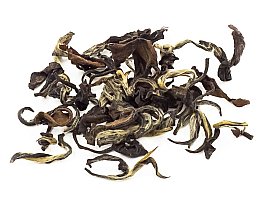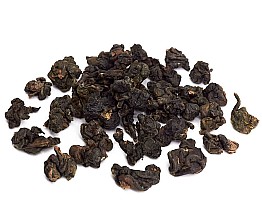2024 Dongfang Meiren White Tea
Harvest: 2018
Elevation: 1300 m
Cultivar: Ruan Zhi (TRES #17)
Availability: In Stock
This Dong Fang Mei Ren is unusual—it’s made without roasting, in the style of white tea. Just the sun, just the bitten leaves—only hardcore!
Let’s start the description with an experiment
It’s probably no secret to you that the Taiwanese sometimes cold brew DFMR in spring water. So, I took a half liter bottle of cold, trusted water, added 5 grams of tea, sealed it, and left it in the fridge for 24 hours.
The next day, after the first sip, I had just one thought: natural wild honey, slightly diluted with water and a touch of fruit. But mostly, pure honey! I find things like this absolutely fascinating.
Hot brews reveal an equally delicate infusion, with a distinct honey profile and a subtle melody of fruit caramel. There’s also a light aroma of teakwood, reminiscent of sheng pu-erh. But honey takes center stage here—rich, unfiltered, and in full bloom.
Another curious aspect of the hot brews, typical of white teas, is the lingering sugar-like sweetness on the root of the tongue. If I hadn’t experienced this firsthand before, I wouldn’t believe it myself. The fresh white tea we handcrafted in 2013 brewed into a distinctly sweet infusion—almost as if sugar had been added. This white Dong Fang Mei Ren performs the same kind of magic.
Like a true white tea, the liquor starts off pale, almost colorless, and gradually deepens into amber—another trait that sets it apart from classic Dong Fang Mei Ren Oolong.
It drinks smoothly, lightly, and effortlessly. It won’t make you tea-drunk, but it will fully satisfy your tea cravings. A perfect choice for an intimate, refined tea session for two.




Reviews (2)
DFMR opens just great — pretty much what I expected. Light, because I didn’t add time for the leaves to get wet, and I backed off my usual 8–9g per 100ml gaiwan, going with 6 or 7 instead. Flavors are in the typical DFMR / Oriental Beauty range: cinnamon and plenty of warm fruit, with brightness covering warm dried fruit and lighter citrus tones. Sometimes people associate muscatel with OB too — I guess that works. Complexity is good, sweetness is great, and feel is a bit rich even for it being so light. Hard to pin down how this is different from a regular oolong. Oxidation seems backed off, but the warm tones tell the opposite story.
With a longer steep (nearly 30 seconds), intensity bumps way up. Cinnamon stands out more, versus lighter dried fruit and citrus — dried apricot, maybe tangerine peel zest. Mouthfeel is full without astringency, and aftertaste lingers. It’s quite pleasant.
Third infusion really shines. Brighter citrus returns. Seems closer to a muscatel designation than ever. Fruit dominates, cinnamon hangs on. Brightness and lightness are pleasant.
Fourth round: still improving. Picking up depth, balancing better. Still clean, balanced, and refined.
DFMR was impressive — it fully matches the description on the website and leaves a long, pleasant aftertaste.














